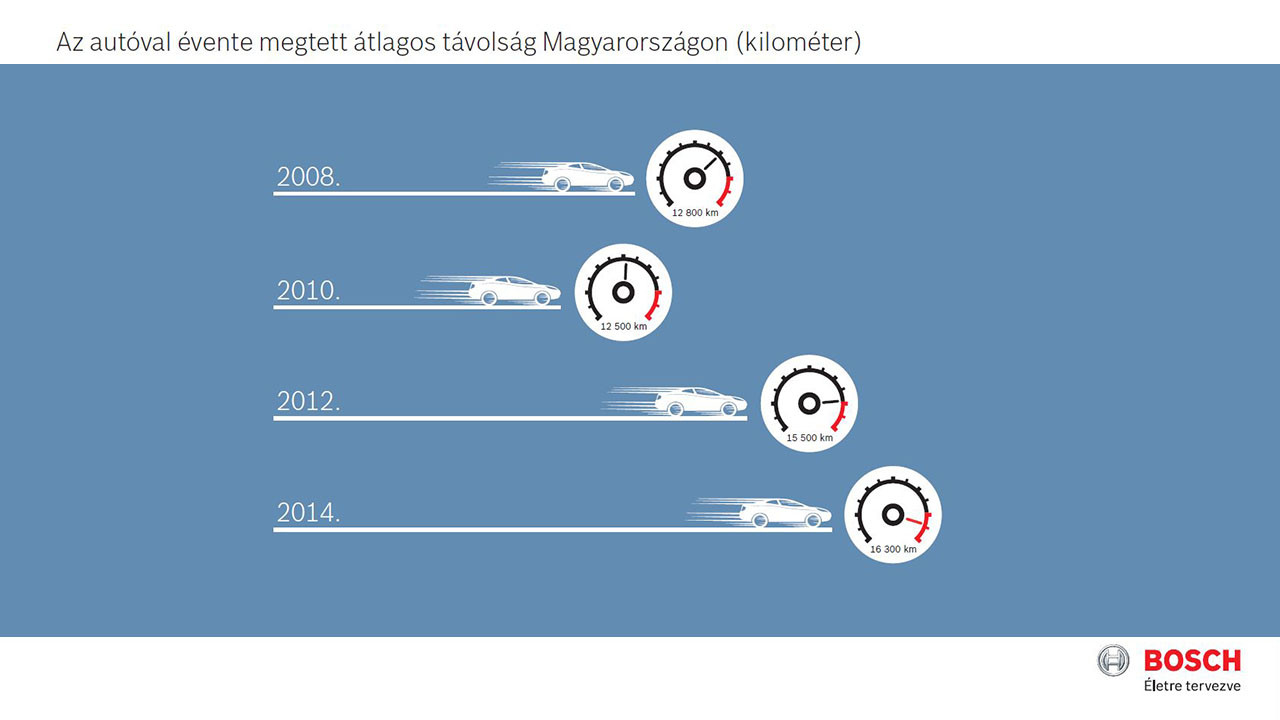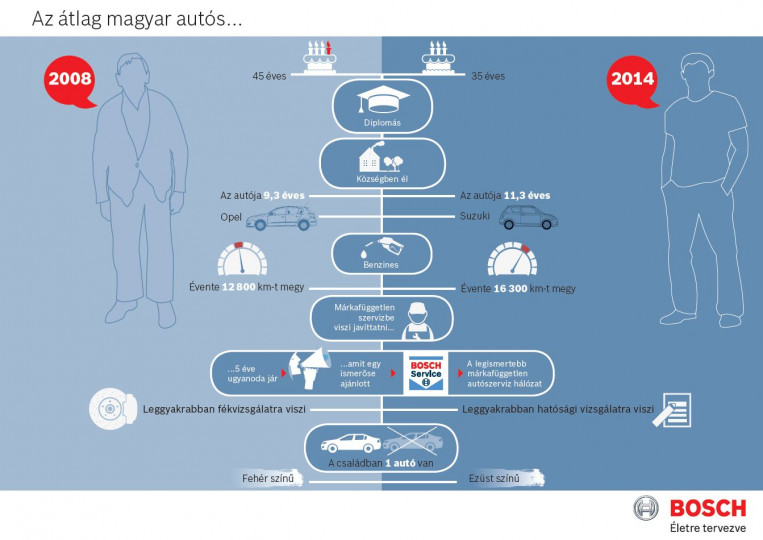This year, Robert Bosch Kft. – the leading international supplier of technologies and services – once again commissioned the Medián Opinion and Market Research Institute to survey cars, car use and car-repair habits in Hungary. Since data of this kind is largely unavailable elsewhere, the research fills a gap. What makes the survey even more valuable is that it has been carried out every two years since 2008, so that it has been keeping track of trends in cars and car-repair habits in Hungary since the start of the economic and financial crisis. The 2014 data was collected from 924 car-using households. The sample was representative by sex, age, level of education and geographical area of the over-18 car-owning population.
The survey shows that Hungarian cars run an average of 16,300 km a year, well up on the 12,500 km figure for the crisis year of 2010, and still more than the 15,500 km of 2 years ago. That means that we are now doing the equivalent of driving our cars from Budapest to Bangkok and back every year. The research shows that people in Budapest and in villages drive further than average. They are the ones who are leaving the crisis behind and again getting behind the wheel.
Budapest drivers go furthest with their cars: an annual average of 19,300 km. So capital-city motorists go the equivalent of half way round the world every year. In 2012, they were driving a distance of only 15,300 km, in 2010, 14,700, and in 2008 – when the crisis began – 14,200. Village-dwellers are sitting in their cars more now, going an annual average of 18,600 km over the last year, against hardly more than 16,000 km two years ago. Interestingly, the distance driven in towns – other than Budapest – actually decreased over the same period from 15,100 to 14,300 km.
People aged 18–29 are driving much more than they were two years ago. On average they do 19,400 km a year, up from only 15,000 two years ago. Before that, the youngest age group drove even less: 12,100 in 2010 and 14,400 in 2008. Over the last two years, the number of kilometres driven has increased in every age group except the 40–49 year-olds.
Not surprisingly, the Hungarian who drive the longest distances have the newest cars. Cars 0–5 years old went an average of 18,000 km in 2012, compared to 20,000 km as measured in this year’s survey. As cars age, the distance they travel each year goes down: owners of 6–10 year-old cars drove them an average of 17,300 km, while those with 11–20 year-old cars managed only 14,500 km. Hungarians with cars more than 20 years old, however, drove them further – 14,900 km a year.
The survey also covered car servicing habits. It found that the vast majority of motorists always go back to the same garage. Every second respondent had been going to the same service garage for 5 years, and the average was six and a half. Bosch will soon be publishing more data on servicing habits.
The Bosch Car Service network
The Bosch Car Service is a brand-independent network of over 14,000 partner garages, tracing its beginnings to 1921, when the founder of the company, Robert Bosch, opened a workshop in Hamburg for servicing auto-electrical products. Over time, the range extended to cover diesel fuelling systems and – in the 1980s – to diagnostics for petrol-injection and anti-lock-braking systems. The full-range Bosch Car Service concept was launched in the late 1990s, by which time Bosch had become the largest independent automotive component manufacturer in the world. The Bosch Car Service network has 87 members in Hungary.
Mónika Hack
+36 70 510 5516
Bosch has been present in Hungary since 1899. After its re-establishment as a regional trading company in 1991, Bosch has grown into one of Hungary’s largest foreign industrial employers. In financial 2013, its 10 Hungarian subsidiaries then had a total turnover of HUF 719 billion and sales of the Bosch Group on the Hungarian market – not counting trade among its own companies – was HUF 161 billion The Bosch Group in Hungary employed more than 8 900 people at the beginning of 2014. In addition to its manufacturing, commercial and development business, Bosch has a network of sales and service operations that covers the entire country.
The Bosch Group is a leading global supplier of technology and services. In 2013, its roughly 281,000 associates generated sales of 46.1 billion euros. (NB: Due to a change in accounting policies, the 2013 figures can only be compared to a limited extent with the 2012 figures). Its operations are divided into four business sectors: Automotive Technology, Industrial Technology, Consumer Goods, and Energy and Building Technology. The Bosch Group comprises Robert Bosch GmbH and its more than 360 subsidiaries and regional companies in some 50 countries. If its sales and service partners are included, then Bosch is represented in roughly 150 countries. This worldwide development, manufacturing, and sales network is the foundation for further growth. In 2013, the Bosch Group invested some 4.5 billion euros in research and development and applied for some 5,000 patents. This is an average of 20 patents per day. The Bosch Group’s products and services are designed to fascinate, and to improve the quality of life by providing solutions which are both innovative and beneficial. In this way, the company offers technology worldwide that is “Invented for life.”
Additional information can be accessed at www.bosch.hu





